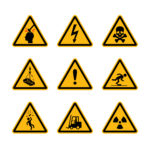 A hazard is anything with the potential to cause harm, like a cutting machine. The potential severity of harm from the machine could be a minor cut needing plaster if you knock into it or a serious cut or amputation if you get a hand caught in it.
A hazard is anything with the potential to cause harm, like a cutting machine. The potential severity of harm from the machine could be a minor cut needing plaster if you knock into it or a serious cut or amputation if you get a hand caught in it.
Some examples of hazards and the injury that could occur are:
- Temperature – Heat stress, sunburn, melanoma, hypothermia, freezer burn, frostnip or frostbite
- Ventilation & humidity – headaches, nausea, tiredness, dry or itchy eyes
- Manual Handling – Back injury, musculoskeletal disorders, hernia and many other injuries
- Work with Display screen equipment (DSE) – Musculoskeletal disorders, eyestrain or eye soreness, headaches and blurred vision, fatigue, occupational stress.
- Tripping and slipping – Injury to any part of the body depending on how you fall and what you are carrying
- Work at heights – Fall of the persons, suspension trauma or objects falling and hitting someone on the ground
- Obstructions – Striking against it, tripping over it as well as blocking emergency escape routes
- Poor Stacking or Storage – Falling materials, back injuries, falls during retrieval.
- Repetitive movements – Musculoskeletal disorders
- Fire and explosion – Burns, health effects of smoke inhalation, exposure to hazardous substances, toxic fumes, psychological trauma
- Hazardous chemical substances – Acute and chronic health effects, allergies. When we know the hazards, we can work out the risk factors and what control measures we need to adapt to reduce or eliminate the risk.
Finally, hazards in the workplace can also cause harm to the environment. This can be things like chemicals getting into to rivers or dust leaving a factory.
We offer a full range of First Aid Equipment and CPR Manikins.

Pingback: Working at Heights pose risks no matter how high or low you are working
Pingback: Slips trips and falls are estimated to cost business over £300 million pounds a year
Pingback: PUWER is the Provision and Use of Work Equipment regulations 1998
Pingback: CHIP is the abbreviated name for the Chemicals (Hazard Information and
Pingback: Food Hygiene Ratings and how they are calculated
Pingback: Managing stress is important to know how to control, whether its work or
Pingback: Eye strain can affect anyone in the office. Your eyes are delicate
Pingback: MSD's or musculoskeletal disorders - Health & Safety Wiki
Pingback: Water extinguisher use demonstration available on our courses
Pingback: GHS regulations - Globally Harmonised System of Classification and
Pingback: HACCP Hazard Analysis & Critical Control Point international accepted
Pingback: As you deploy escape breathing apparatus, you can hear it going off
Pingback: Temperature in the Workplace is regulated over to ensure environment
Pingback: Risk assessment are completed to identify possible causes of harm